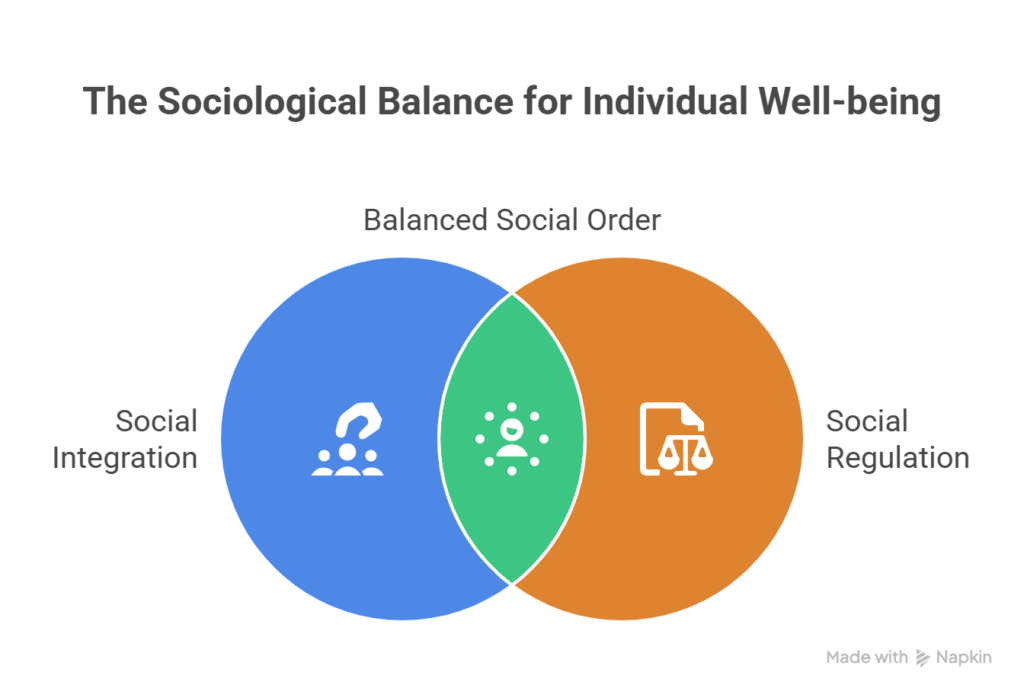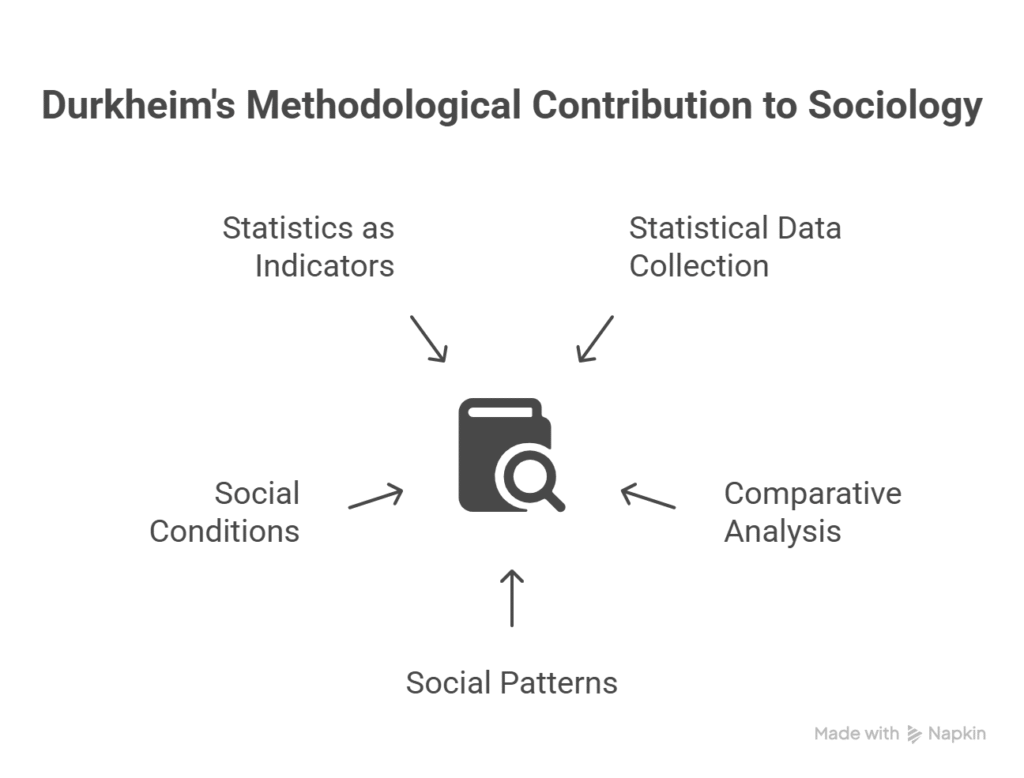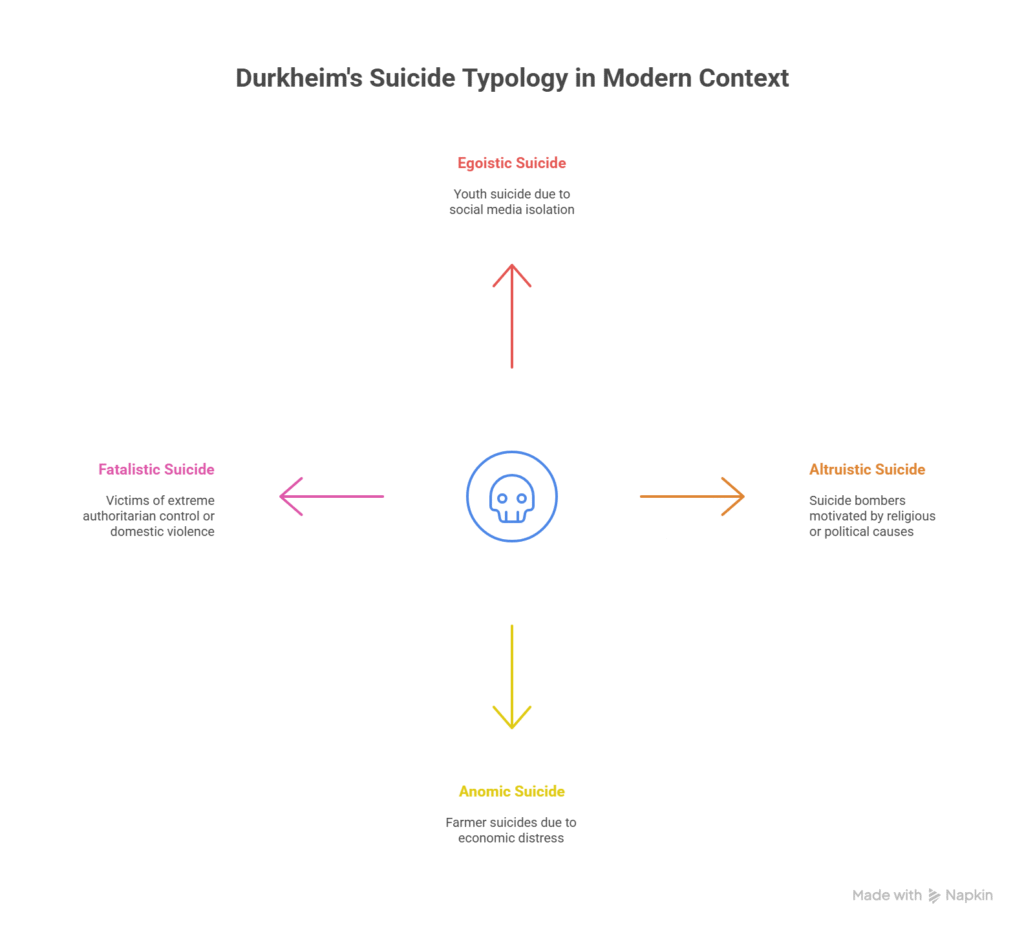Introduction
Suicide has long been a topic of moral, psychological, and religious concern. Traditionally, philosophers and theologians explained it as an act of individual weakness, sin, or psychological abnormality. However, in the late nineteenth century, French sociologist Émile Durkheim revolutionized the study of suicide by interpreting it through a sociological lens. His book “Le Suicide” (1897) is considered one of the earliest and most influential works in sociology that systematically analyzes suicide as a social fact, not merely an individual tragedy. Durkheim’s theory of suicide highlights the role of social integration and social regulation in human life and demonstrates how the weakening or strengthening of these forces influences suicidal behavior.
Suicide as a Social Fact
Durkheim emphasized that suicide is not solely the outcome of personal emotions or psychological disturbances. Instead, it is deeply rooted in the structure of society. By analyzing suicide rates across different social groups, religions, occupations, and regions, he found consistent patterns that could not be explained by individual psychology alone.
For instance, Durkheim observed that:
- Protestants had higher suicide rates than Catholics.
- Unmarried individuals showed higher rates than married ones.
- Urban areas reported more suicides than rural regions.
These differences, according to Durkheim, proved that suicide is a social fact—a phenomenon shaped by collective conditions rather than personal choices alone.
Key Concepts: Integration and Regulation
Durkheim’s theory rests on two core sociological dimensions:

- Social Integration – the degree to which individuals are connected to a social group, community, or collective life. High integration fosters belonging and support, while low integration leads to isolation.
- Social Regulation – the degree of control and guidance society exerts on individual desires and expectations. Adequate regulation creates order and balance, while lack of regulation or excessive regulation disturbs the individual’s sense of purpose.
Durkheim argued that suicide rates increase when integration or regulation is either too weak or too strong.
Types of Suicide
Durkheim classified suicide into four distinct types based on variations in integration and regulation.
1. Egoistic Suicide
- Cause: Low social integration.
- Explanation: When individuals feel detached from society, family, or religion, they lack a sense of belonging. This isolation leads to purposelessness and despair.
- Example: Protestants in Durkheim’s study had higher suicide rates because their religious community emphasized individual conscience rather than collective rituals, unlike Catholicism, which created stronger communal bonds.
Egoistic suicide is thus linked to modern individualism, where weakening of traditional ties leaves individuals vulnerable.
2. Altruistic Suicide
- Cause: Excessive social integration.
- Explanation: When individuals are too strongly bound to a group, they may sacrifice their lives for the collective good, seeing their own life as insignificant compared to group interests.
- Example: Soldiers sacrificing their lives in war, religious martyrs, or members of traditional societies where widow immolation (like sati in historical India) was practiced.
Here, suicide is not an act of loneliness but of duty, honor, or loyalty to the group.
3. Anomic Suicide
- Cause: Low social regulation.
- Explanation: Anomie, a concept coined by Durkheim, refers to a state of normlessness where societal rules fail to regulate individual desires. In times of sudden social or economic change—whether prosperity or crisis—people’s expectations become unregulated, leading to disappointment and frustration.
- Example: Sudden economic depressions, job losses, or even unexpected wealth can trigger anomic suicides, as individuals struggle to adjust to disrupted norms.
This type of suicide highlights the importance of societal regulation in curbing unrestrained desires.
4. Fatalistic Suicide
- Cause: Excessive social regulation.
- Explanation: When individuals are subjected to extreme oppression or rigid rules, their future appears hopeless. Under these conditions, suicide may occur as an escape from intolerable constraint.
- Example: Slaves under harsh control, prisoners with no freedom, or individuals trapped in authoritarian regimes.
Though Durkheim gave less emphasis to fatalistic suicide compared to others, it completes the theoretical framework.
Methodological Contribution
Durkheim’s study of suicide was groundbreaking in its methodology. He collected and compared statistical data on suicide across different societies and groups. This comparative method revealed consistent social patterns, allowing him to argue convincingly that suicide rates are influenced more by social conditions than by individual pathology.
He treated statistics not as mere numbers but as indicators of the collective state of society. By linking individual actions to social structures, Durkheim established sociology as a distinct discipline separate from psychology and philosophy.

Sociological Significance
Durkheim’s suicide theory carries immense significance in sociology:
- Shift from Individual to Society – He shifted focus from personal motives to broader social causes, emphasizing that even private acts like suicide are influenced by collective conditions.
- Foundation of Sociology of Deviance – By analyzing suicide, Durkheim laid the groundwork for studying deviant behavior through social norms, integration, and regulation.
- Relevance to Modern Society – Contemporary issues like rising suicide rates due to social isolation, economic stress, and mental health challenges can still be analyzed using Durkheim’s framework.
- Concept of Anomie – The idea of anomie has become central in sociology, extending beyond suicide to explain crime, social unrest, and alienation in modern industrial societies.
Criticisms of Durkheim’s Theory
While Durkheim’s work is pioneering, it has faced several criticisms:
- Overemphasis on Social Factors – Critics argue that he underestimated psychological, biological, and personal dimensions of suicide, such as depression or genetic predisposition.
- Data Reliability – The accuracy of suicide statistics in the nineteenth century has been questioned. Many suicides may have been misreported due to stigma.
- Neglect of Gender Differences – Durkheim did not deeply analyze gender, even though men and women often show different suicide patterns.
- Reductionism – By classifying suicides strictly into four types, Durkheim may have oversimplified the complex interplay of motives behind self-destruction.
Despite these criticisms, his framework remains a cornerstone in sociological research.
Contemporary Relevance
In today’s context, Durkheim’s theory remains strikingly relevant. Issues like youth suicide due to social media isolation (egoistic), suicide bombers motivated by religious or political causes (altruistic), economic distress leading to farmer suicides in developing countries (anomic), and victims of extreme authoritarian control or domestic violence (fatalistic) can all be explained through his typology.
Moreover, with growing concerns about mental health worldwide, Durkheim’s sociological approach complements psychological perspectives by showing that suicide is not just a matter of individual pathology but also of social environment.

Conclusion
Émile Durkheim’s “Suicide” remains a classic in sociology because it transforms a deeply personal act into a sociological phenomenon. By categorizing suicide into egoistic, altruistic, anomic, and fatalistic types, he demonstrated how variations in social integration and social regulation shape human behavior. While some aspects of his theory face criticism, the core idea—that suicide is influenced by the collective life of society—continues to guide research and policy on mental health, social cohesion, and human well-being.
Durkheim’s theory teaches us a profound lesson: the stability of society and the strength of social bonds are not abstract concepts but vital forces that can determine life or death. In this way, his work not only advanced sociology but also deepened our understanding of the fragile connection between individual existence and social order.
Do you like this this Article ? You Can follow as on :-
Facebook – https://www.facebook.com/hubsociology
Whatsapp Channel – https://whatsapp.com/channel/0029Vb6D8vGKWEKpJpu5QP0O
Gmail – hubsociology@gmail.com
Topic-related questions
5 Marks Questions
- What does Durkheim mean by suicide as a “social fact”?
- Define egoistic suicide with an example.
- Differentiate between egoistic and altruistic suicide.
- What is the role of social integration in Durkheim’s theory of suicide?
- Give one criticism of Durkheim’s theory of suicide.
10 Marks Questions
- Explain Durkheim’s concept of anomic suicide with suitable examples.
- Discuss the relationship between social regulation and suicide according to Durkheim.
- How did Durkheim use comparative statistics in his study of suicide?
- Explain the differences between altruistic suicide and fatalistic suicide.
- “Suicide is influenced more by social conditions than by individual motives.” – Explain with reference to Durkheim.
15 Marks Questions
- Critically examine Durkheim’s theory of suicide, highlighting its contributions and limitations.
- Discuss in detail the four types of suicide identified by Emile . How are they related to integration and regulation?
- Explain Émile’s concept of anomie and evaluate its relevance in understanding suicide in contemporary society.
- Assess the sociological significance of Émile’s study of suicide in establishing sociology as a distinct discipline.
- How can Émile’s theory of suicide be applied to explain the rising cases of suicide in modern society, such as youth suicide, farmer suicides, or suicide bombings?
